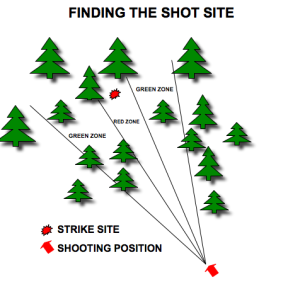Wayne Rollinson takes us through marking the shot position and finding the strike area with least damage or contamination, just incase you need a tracking team to come in for recovery…
DO NOT walk the red zone to the bullet strike and shot site all you do is destroy evidence and then lay more tracks with blood, particles and everything you pick up on clothing from the shot site unknowingly.
Walk each side and stay clear of the red zone by at least 3 metres
This ensures you remain clear of any particles. If you’re with someone else, have the shooter in the seat or at the shooting position and guide you in to shot site.
Carefully approach the area till you are in the correct position.
Once located you can now look for the strike area and debris this may take a while to build up a picture of what has happened.
Once determined you can now plan for the next course of action.
Questions to ask about the situation;
• Which way did the beast run?
If you saw the beast run and have little to go on at the shot site slowly move to the way it ran often animals don’t leave the bone actually on the shot site but as they move legs or parts start to swing, this will leave bone particles and blood behind.
• What calibre was used?
Certain calibres leave less sign at the strike than others but after a short while blood and bone will be present.
• What bullet weight and type of bullet?
The bullet makes a huge difference to leaving shot site evidence.
Is there a difference between a lead bullet and a copper one?
• What distance was the shot attempted at?
Distance is another part to play in the shot sight. If you are standing, can you see the bullet path?
• How did the Deer react to the shot?
Reaction, not many see this but it does help. Did the beast run off walk off?
Try and keep your dog away from the area at the start, this gives you a chance to work out what happened. Do not go in straight away not knowing what you are tracking, a lot of blood at the strike is not always an indicator of a good shot, unless lung tissue is present then a short take a short break before follow up on a dead beast.
The only two positive indicators with regards to blood are lung shot and a spleen strike. A spleen strike will be indicated by dark blood with a brighter outer ring.
When looking at blood, pretty much all of the other parts of the body will indicate the same.
Follow up on any wounded animal is the result of evidence collection… adding up what you find will determine the best course of action.
Sometimes leaving a beast for 4 hours plus can be the best course of action to successfully recover or dispatch that animal.
Call UK Scent Hound Association for assistance if needed we are always there to help leave a message on our free phone number
Telephone 0800 689 0857
Facebook UKSHA
Website www.uksha.co.uk

